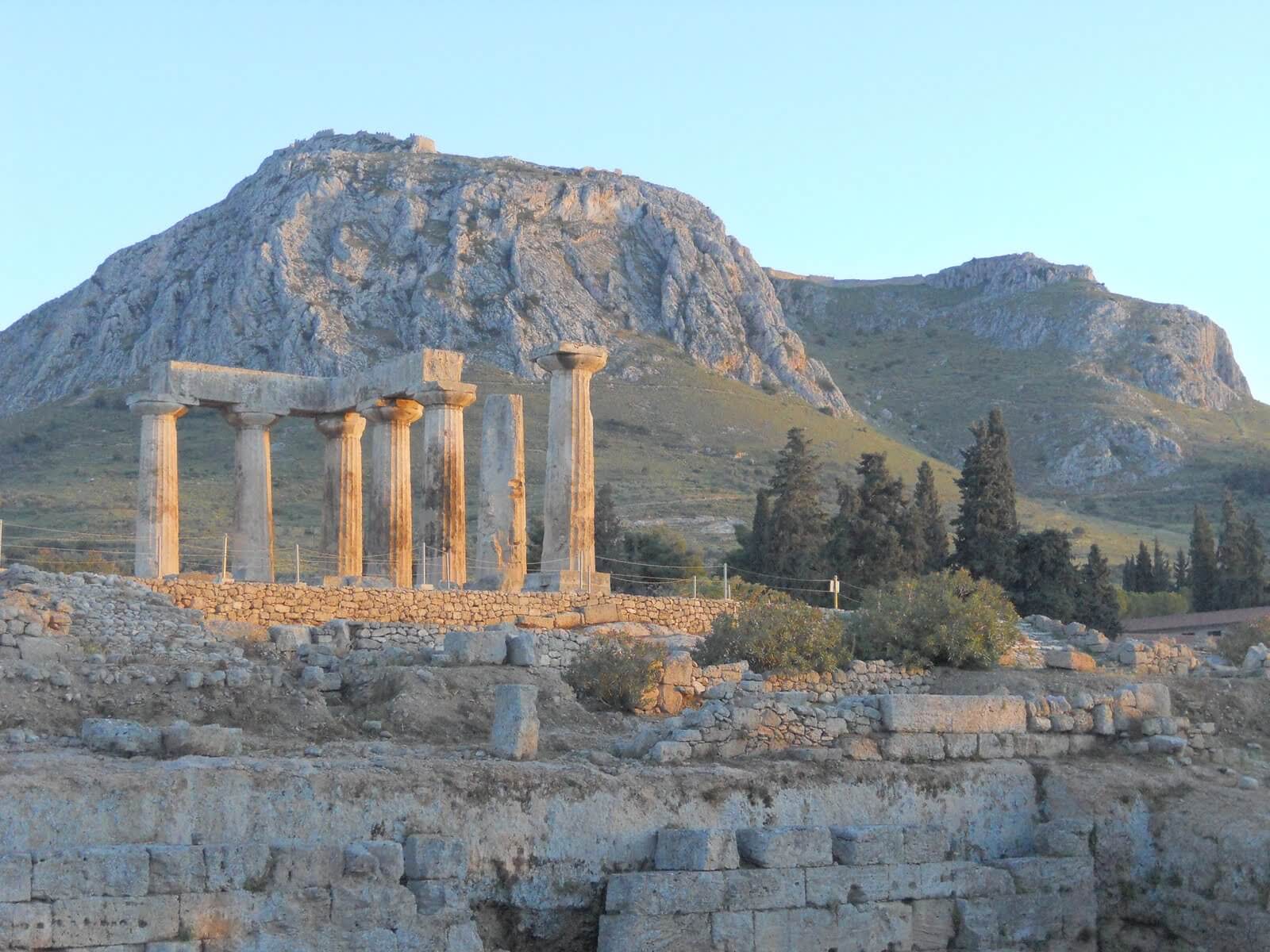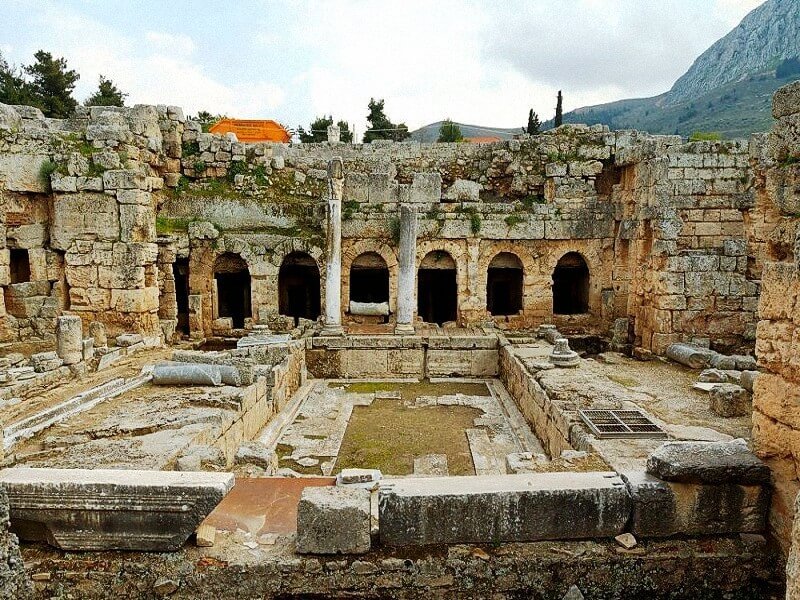
Corinth

Brief Overview
In classical times, Corinth rivalled Athens and Thebes in wealth, based on the Isthmian traffic and trade. Until the mid-6th century, Corinth was a major exporter of black-figure pottery to city-states around the Greek world, later losing their market to Athenian artisans.
In classical times and earlier, Corinth had a temple of Aphrodite, the goddess of love, employing some thousand hetairas.
The city was renowned for these temple prostitutes, who served the wealthy merchants and the powerful officials who frequented the city. Lais, the most famous hetaira, was said to charge tremendous fees for her extraordinary favours. Referring to the city's exorbitant luxuries, Horace is quoted as saying: "Not everyone is able to go to Corinth".
Corinth was also the host of the Isthmian Games. During this era, Corinthians developed the Corinthian order, the third main style of classical architecture after the Doric and the Ionic.
The Corinthian order was the most complicated of the three, showing the city's wealth and the luxurious lifestyle, while the Doric order evoked the rigorous simplicity of the Spartans, and the Ionic was a harmonious balance between these two following the cosmopolitan philosophy of Ionians like the Athenians.
The city had two main ports: to the west on the Corinthian Gulf lay Lechaion, which connected the city to its western colonies (Greek: apoikoiai) and Magna Graecia, while to the east on the Saronic Gulf the port of Kenchreai served the ships coming from Athens, Ionia, Cyprus and the Levant. Both ports had docks for the city's large navy.
During the years 481-480 BC, the Conference at the Isthmus of Corinth (following conferences at Sparta) established the Hellenic League, which allied under the Spartans to fight the war against Persia.
The city was a major participant in the Persian Wars, sending 400 soldiers to defend Thermopylae and supplying forty warships for the Battle of Salamis under Adeimantos and 5,000 hoplites with their characteristic Corinthian helmets in the following Battle of Plataea.
The Greeks obtained the surrender of Theban collaborators with the Persians. Pausanias took them to Corinth where they were put to death.
Herodotus, who was believed to dislike the Corinthians, mentions that they were considered the second best fighters after the Athenians.
In 458 BC, Corinth was defeated by Athens at Megara.

In Detail
Corinth
Corinth, Greek Korinthos, an ancient and a modern city of the Peloponnesus, in south-central Greece. The remains of the ancient city lie about 50 miles (80 km) west of Athens, at the eastern end of the Gulf of Corinth, on a terrace some 300 feet (90 metres) above sea level. The ancient city grew up at the base of the citadel of the Acrocorinthus - a Gibraltar-like eminence rising 1,886 feet (575 metres) above sea level. The Acrocorinthus lies about 1.5 miles (2.5 km) south of the Isthmus of Corinth, which connects the Peloponnese with central Greece and which also separates the Saronic and Corinthian gulfs from each other. The citadel of the Acrocorinthus rises precipitously above the old city and commands the land route into the Peloponnese, a circumstance that gave Corinth great strategic and commercial importance in ancient times.
The site was occupied from before 3000 bc, but its history is obscure until the early 8th century bc, when the city-state of Corinth began to develop as a commercial centre. Corinth's political influence was increased through territorial expansion in the vicinity, and by the late 8th century it had secured control of the isthmus. The Corinthians established colonies at Corcyra and Syracuse, which would later assure them a dominant position in trade with the western Mediterranean.
During the 8th and 7th centuries Corinth was ruled by the Bacchiad family of nobles, but they were eventually overthrown by Cypselus, who, followed by his son Periander, ruled the city as tyrants from about 657 to 550. These tyrants founded further colonies, but the chief source of Corinth's wealth remained its possession of the isthmus, which controlled not only the land traffic between Attica and the Peloponnese but also the traffic between the Aegean and Ionian seas by way of the Corinthian and Saronic gulfs. Periander facilitated the transit of ships and cargoes, which were hauled overland from gulf to gulf, by building a stone roadway between them, thus sparing seafarers the arduous voyage around the southern tip of the Peloponnese. By this time Corinth had harbours on both gulfs that flanked it, Lechaeum on the Gulf of Corinth and Cenchreae on the Saronic Gulf. Under the tyrants, Corinth's colonial expansion was extended along the Adriatic and into Macedonia.
The tyranny of the Cypselids was followed in about 550 bc by an oligarchical government that embarked on a major building program for the city. In the second half of the 6th century, however, Corinth was outstripped by Athens in both seamanship and commerce, and it was often the bitter commercial rivalry between Corinth and Athens that was to generate crises in Greek politics over the next 200 years. After the Greco-Persian Wars (c. 546-c. 448 bc), Corinth joined Sparta against Athens during the Peloponnesian War (431-404 bc), but, though that conflict brought about the military defeat of Athens, it did little to revive the power of Corinth, which joined with some of its former allies to defeat Sparta in the Corinthian War (395-387 bc).
Corinth was subsequently involved in most of the political conflicts of Greece, but chiefly as a pawn in the struggles of more powerful city-states because of the strategic value of its citadel. Corinth's independence finally ended in 338 bc when Philip of Macedon garrisoned the Acrocorinthus and made the city the centre of the League of Corinth. The city remained the puppet of Macedonia and subsequently of the Achaean League until the latter involved it in a fatal conflict with Rome, and in 146 bc Corinth was destroyed by the Roman general Lucius Mummius.
In 44 bc Julius Caesar reestablished Corinth as a Roman colony. The new Corinth flourished and became the administrative capital of the Roman province of Achaea. The city is known to readers of the New Testament for the letters addressed to its Christian community by the apostle Paul. It enjoyed some prosperity under Byzantine rule but declined in the later European Middle Ages. After the Turkish conquest in 1458, it was reduced to a country town.
The remains of the ancient city of Corinth lie just north of the Acrocorinthus, with which it was joined by a circuit wall about 6 miles (10 km) in circumference. The city was connected with its principal port, Lechaeum, by two parallel walls and a paved highway which led to the propylaea, the entrance to the agora (the city's main marketplace). Most of the substantial remains in the agora are works from the Roman period, but it acquired its present extent much earlier, in the 4th century bc, with the construction of an enormous stoa (portico), 525 feet (160 metres) in length, that enclosed its southern side. Immediately behind the south stoa began the road leading to the city's other port of Cenchreae, on the Saronic Gulf. On a small rise northwest of the agora stand seven Doric columns, which are the remains of the Temple of Apollo (c. 550 bc). The remains of other temples, villas, a theatre, shops, public baths, pottery factories, a gymnasium, a large triumphal arch, and other buildings dot the site, which since 1896 has been extensively excavated.
Modern Corinth, three miles northeast of the site of ancient Corinth, was founded in 1858 after an earthquake leveled the latter. It is primarily a hub of communications between northern and southern Greece and is the primary point of export for local fruit, raisins, and tobacco. It is also the chief town of the nomos (department) of Corinth and the seat of an archbishop. Pop. (2001) 29,787.
[1]
Official Website and Map
Further Sources
[1] "Encyclopaedia Britannica"
"Ancient History Encyclopedia"
"The American School of Classical Studies"
"Sacred Destinations"
Our Mobile Application
Check out Our Mobile Application "Ancient Greece Reloaded"


